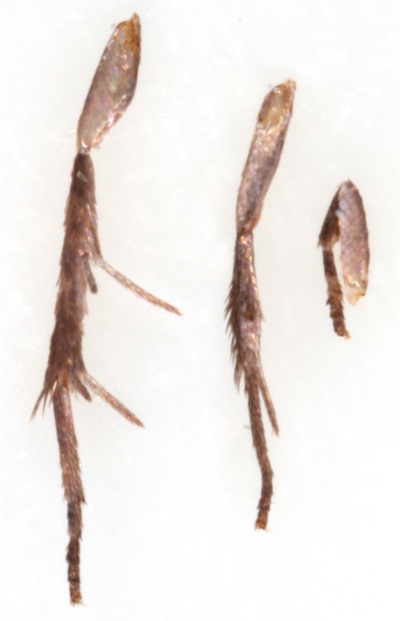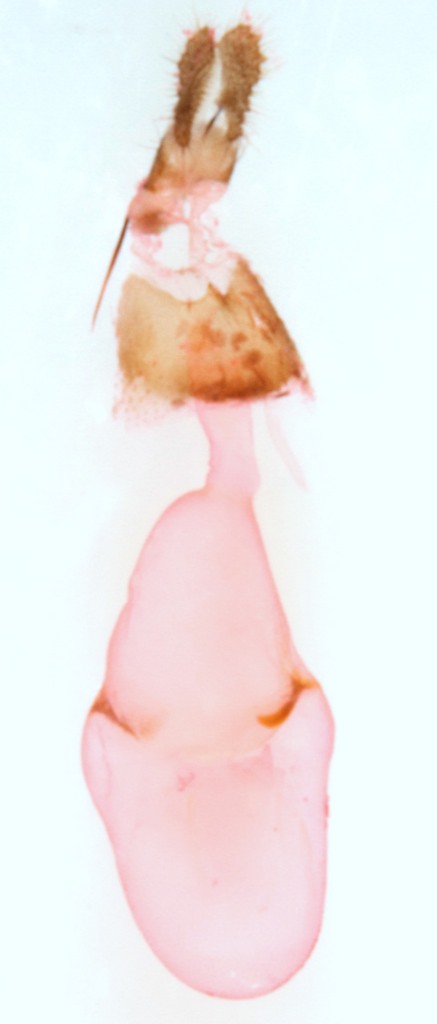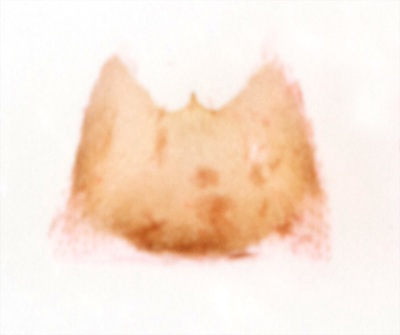49.382 Strophedra nitidana (Little Oak Tortrix)
ws: 8-10mm; May-Jun; oak (Quercus spp); NS-B oak woods in S.England & Wales
ID: The two Strophedra species appear very similar and Pammene germmana is also small, black with whitish costal strigulae, palps and frons. S.nitidana is smaller than either of these species (ws10-12mm and 10-14mm respectively). The costal strigulae are relatively well-defined in S.nitidana and relatively obscure in S.weirana. I would think genital dissection is required to confidently separate these 3 species.
Male genitalia: As in other Grapholitini the tegumen of Strophedra species is a simple arch; in the Strophedra species this arch is quite elongate, about 2x as long as broad in Strophedra and about as long as broad in P.germmana. The two Strophedra species differ as follows: in S.weirana the aedeagus is without cornuti, in S.nitidana the aedeagus contains 4 or 5 rows of densely barbed spines; the cucullus of S.nitidana is more elongate (about twice as long as broad in S.nitidana, about 1.5x as long as broad in S.weirana); the apex of the tegumen is produced to a finer point in S.nitidana.
Female genitalia: Strophedra species are distinct in having a pointed central projection on the posterior margin of the ventral S8 (periostial) plate. MBGBI5.2 illustrates both Strophedra species (p359 figs 363 & 364) but does not describe the differences. Pierce and Metcalfe states that the signa are shorter in S.weirana. Only S.nitidana is shown at Dissection Group. In the MBGBI illustrations the signa of S.nitidana are drawn with a longer, finer and probably more curved thorn than those of S.weirana; a short sclerotisation in the ductus bursae just posterior to the ostium is drawn narrow with parallel sides in S.weirana and broader with slightly indented sides in S.nitidana; in S.weirana the ductus bursae gradually expands from the sclerotisation towards the bursa, in S.nitidana the ductus bursae is more-or-less parallel-sided and the junction with the bursa better defined.
Male genitalia: As in other Grapholitini the tegumen of Strophedra species is a simple arch; in the Strophedra species this arch is quite elongate, about 2x as long as broad in Strophedra and about as long as broad in P.germmana. The two Strophedra species differ as follows: in S.weirana the aedeagus is without cornuti, in S.nitidana the aedeagus contains 4 or 5 rows of densely barbed spines; the cucullus of S.nitidana is more elongate (about twice as long as broad in S.nitidana, about 1.5x as long as broad in S.weirana); the apex of the tegumen is produced to a finer point in S.nitidana.
Female genitalia: Strophedra species are distinct in having a pointed central projection on the posterior margin of the ventral S8 (periostial) plate. MBGBI5.2 illustrates both Strophedra species (p359 figs 363 & 364) but does not describe the differences. Pierce and Metcalfe states that the signa are shorter in S.weirana. Only S.nitidana is shown at Dissection Group. In the MBGBI illustrations the signa of S.nitidana are drawn with a longer, finer and probably more curved thorn than those of S.weirana; a short sclerotisation in the ductus bursae just posterior to the ostium is drawn narrow with parallel sides in S.weirana and broader with slightly indented sides in S.nitidana; in S.weirana the ductus bursae gradually expands from the sclerotisation towards the bursa, in S.nitidana the ductus bursae is more-or-less parallel-sided and the junction with the bursa better defined.
§1 Belfairs Woods, Essex; 18/07/2014; female; fw 4.1mm
§2 Orlestone Forest, Kent; 18/05/2020; male; fw 4.2mm
All images © Chris Lewis
§2 Orlestone Forest, Kent; 18/05/2020; male; fw 4.2mm
All images © Chris Lewis
Page published 18/01/2015 (§1) | §2 added 30/05/2020



















